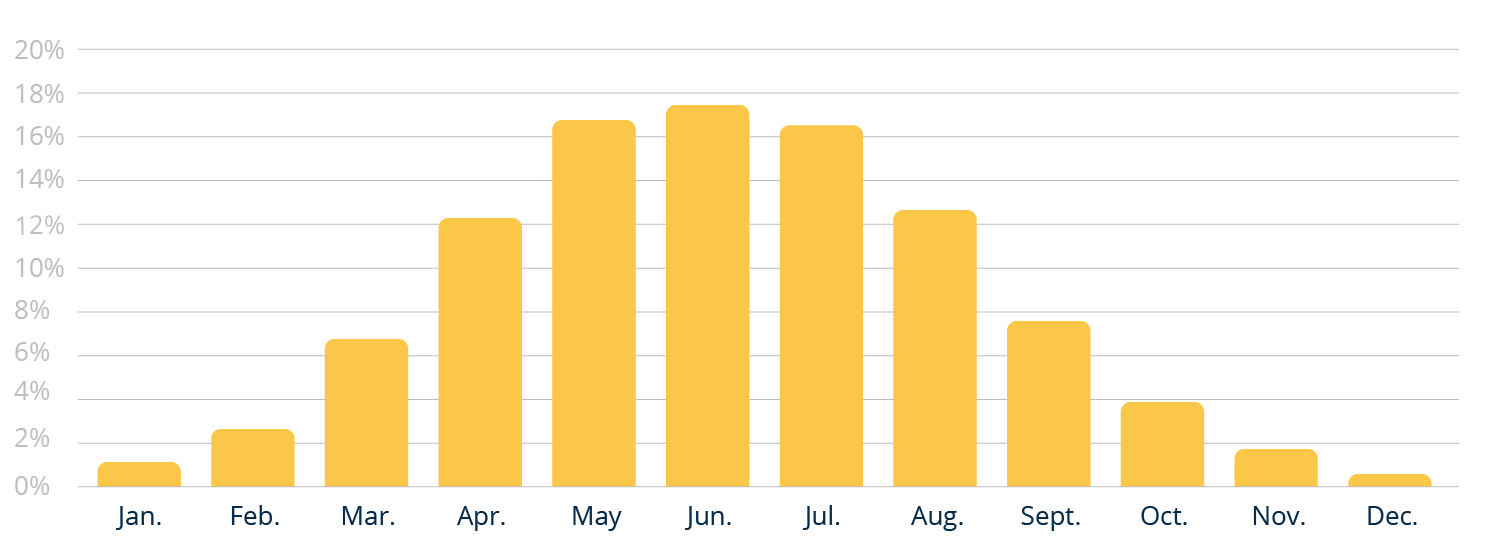Solar energy
Innovative solution.
Oma Päike is the new energy solution of Eesti Gaas for apartment associations and companies.
We build an individual solar power plant on the roof or territory of the customer’s building and sell the electricity it produces to the customer.
Own investment 0.
The construction of the solar plant will not incur any costs or administration obligations for the customer. Eesti Gaas will carry out the whole investment and installation and will later remain the owner of the production unit in order to maintain the solar panels.
Suitability.
The customer purchases electric power and starts saving money from the moment the panels start producing electricity. Savings on network charges for electrical power generated and used are ca 1500€ annually – network charge 0 EUR.
For who
Oma Päike energy solution is suitable for apartment associations with common electricity purchase, small and medium-sized enterprises, schools and kindergartens whose electricity consumption totals at least 20,000 kWh.
- A free space of 600 m2 is required on the roof or the ground. The area of the panels must not be obscured by high-rise buildings or plants.
- The 50 kW system produces an average of 48,5 MWh per year, which meets the consumption of approximately 15 households.
FAQ
- Small and medium-sized companies, apartment associations with common electricity purchase (purchases done based on a single apartment association meter), schools and kindergartens.
- Solar panels can be mounted on both flat and gabled roofs.
- The roof should have enough space that is free of shadows and technical systems:
- ~400 m2 for a gable roof
- ~1000 m2 for a flat roof
- The panels can also be mounted on a free area of land of ~1000 m2.
- Systems that are mounted on flat roofs are more flexible and allow you to change the orientation of the solar panels, regardless of the position of the building. Because of this, the direction of the roof in these cases is irrelevant.
- In the case of gable roofs, a south-facing roof maximises the yield, but we can also mount panels on roofs that fall between the south-west and the south-east direction.
- In both cases, it is important that the south side of the building does not have any objects obstructing sunlight (high-rise buildings, etc.).
- Before mounting any solar panels, our experts will ensure that the roof structures comply with the additional load from solar panels.
- You do not have to pay any part of the cost of mounting the panels. Eesti Gaas will cover the investment and installation and will later remain as the owner of the production unit to maintain solar panels. You will purchase the produced electric power.
- If desired, an advance payment may be made for a certain amount of electricity. In this case, it is possible to offer a more favourable price for solar power.
- You will start saving money from the moment the panels start producing electricity.
Producing electricity from solar power
- Electricity is produced from solar power in solar panels, which convert light into electricity. In addition to solar panels, the system includes an inverter, which is responsible for transforming electricity from panels into electricity that is equivalent to the quality of the power network. From the inverter, electricity is transmitted for on-site consumption as an alternative to network electricity.
- In Estonia, the potential for solar power production is similar to Germany (10% of German electricity consumption is met using solar power). The production of electricity from the sun is positively influenced by cooler temperatures, which compensate for shorter production time.
- In Estonia, the solar system produces the most electricity in May, June and July. Nearly 40% of total annual electricity production takes place in the summer months.
- Yes, electrical equipment works from both sources (network electricity and solar electricity) in exactly the same way.
- Under good installation conditions, a production plant with a capacity of 1 kW per year provides ~970 kWh of electricity.
- So, for example, a 50 kW system produces an average of ~48,000 kWh per year, which covers the consumption needs of around 15 households.
- A building that has solar panels will remain connected to the grid. If the electricity produced by the panels does not cover all consumption, the deficit amount will automatically be taken from the power network.
- The excess solar energy from consumption is transmitted to the power network.
- Production data can be monitored in real time on the inverter’s information board. In addition, clients can see an overview in the web application.


